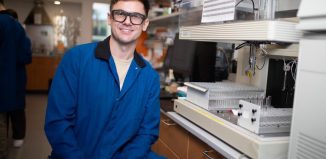BNL’s Pulecio drawn to study of magnetic spin
Even when most electronics aren’t functioning or are in sleep mode, they consume power. Leaving an inactive laptop long enough without charging it causes the battery to drain.
That’s not the case, however, with a developing technology called spintronics. Researchers are developing ways to use the spin of particles to operate DVR devices, smart phones and space technologies.
“The hope with spintronics is that you save the state and you won’t consume energy,” explained Javier Pulecio, a research associate in physics at Brookhaven National Laboratory. “When you turn it on, it’s instantly on. It has everything saved in its current position.” It is, Pulecio explained, like a refrigerator magnet, which stays magnetized.
Spintronic technology is still in the early stages of development, said Pulecio, with some significant fundamental hurdles to overcome before it will have widespread application in consumer electronics. One of the challenges is figuring out how to transport an electron’s spin over a longer distance, enabling it to become a useful carrier of a signal.
If scientists put an electron with a particular spin through a copper wire, the approximate distance the spin will stay polarized (or in the same state it was in when it entered the wire) is about 2 nanometers. In a normal conductor, the electron scatters, which causes the spin to change state or “flip.”
For perspective, an inch is 25,400,000 nanometers. The distance for that signal is “really tiny,” Pulecio said. “Current transistor technology is much larger than that.”
One possible solution is graphene, which is pure, two-dimensional carbon that is one atom thick. Graphene enables an electron to stay polarized for longer distances — microns instead of nanometers. It allows electrons to move without scattering, an activity known as ballistic transport.
Pulecio recently led a team that published a paper in Nature Communications that described how they created nanodevices with magnetic vortices in them. The configuration of the vortex is like a hurricane. It has a core, like the eye of a storm, with a circular magnetization around the center, like the clouds circling the eye.
He used two discs of different thicknesses but similar diameter on top of one another. This created orbits of spinning electrons of different sizes.
Even though the two discs had orbits that wanted to move differently, they synchronized through strong interactions to create a new orbit size during the motion. The electrons from the disc with the smaller-sized orbit were pulled out to an orbit that was closer to the larger one.
Pulecio’s mentor Dario Arena, a physicist in the photon sciences directorate at BNL, described the results in this experiment as “very promising.”
While Pulecio is still “quite young by the standards in the field,” Arena said “colleagues from other institutions have commented on how impressed they are with his results.”
Pulecio is studying other magnetic quasiparticles, such as skyrmions, which could lead to a reduction of the energy necessary to excite them by six orders of magnitude (or by a million times). He is interested in trying to bridge the fundamental science to its application. He hopes to contribute to creating smaller, more energy-efficient devices.
Arena explained that spintronics has current applications.
“Spintronics is not an abstract curiosity in the lab,” Arena said. “It is the foundation underpinning our advanced hard drives on computers. Even as more and more personal computers are moving toward solid-state hard drives, magnetic hard disk drives are finding an even more important application in cloud-based services such as Netflix, Dropbox, iCloud and many others.”
Arena said spintronic devices are marketed by companies such as Freescale, a spinoff of Motorola. While it isn’t currently used in consumer electronics, spintronics has found application in “harsh” environments where traditional semiconductor memory may have deficiencies, he said.
A resident of Wading River, Pulecio and his wife Alexandra, who is a science educator at BNL, welcomed a son, Xavier John, to their family eight months ago.
Born in Chicago and raised in Tampa, Fla., Pulecio said he enjoys mountain biking and fishing in and around Long Island. Pulecio’s mother Catalina, who grew up in Colombia, came to the United States because she saw greater opportunities for her family.
She didn’t speak English well when she arrived and made considerable sacrifices, he said. For his siblings and him, it was never a question of if they were going to college, but when and where.
Pulecio said he appreciates the opportunities he has at BNL. “My group leader Yimei Zhu and mentor Dario Arena have provided me with amazing support and guidance,” he said. “Our ability to understand, alter and control material at the atomic level makes this a truly exciting time to be a scientist.”






